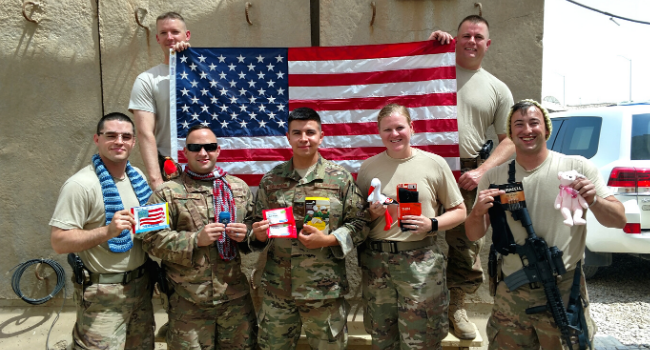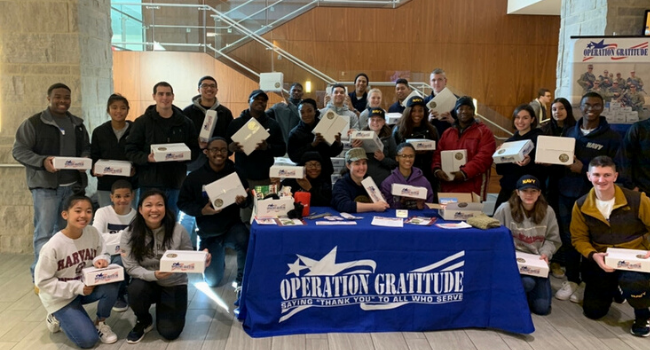As you help us achieve the impossible during a global pandemic yet again, I want to share a few reflections about the 18,000 care packages we will send and their critical importance at a time when many people have forgotten that our nation is still at war.
While this post is a little longer than usual, I’m asking you to take five minutes to read it, because it is a heartfelt message I’ve written for you.
It’s Not Just a Care Package

Last year I shared a series of Weekly Briefings to create a better understanding of what we do as an organization. It was a “labor of love” that I hoped would adequately describe the true impact we make on the lives of our recipients and our volunteers.
Make no mistake about it: when I sent you those Weekly Briefings explaining “it’s not just a care package” or a “thank you,” my intent was not only to emphasize how simple acts of gratitude make a difference. I wrote them to encourage and inspire all of our volunteers to go a step beyond saying thank you by making more meaningful connections with those who serve our nation.
For more than 30 years in uniform and as a nonprofit leader, I have seen firsthand the disconnectedness that military, first responders, and their families feel in their communities. There is nothing that makes me prouder than being part of an organization that helps to bring those who serve closer to their civilian neighbors. I’ve never experienced a greater feeling in life than serving alongside grateful Americans like you who want the men and women who protect our communities to feel appreciated and understood.

Building Bridges
As I type these words, I remember talking to our founder, Carolyn Blashek, for the very first time in October of 2017 about why I wanted to become a part of Operation Gratitude.
I remember staying up all night trying to perfect a simple one-page strategic plan, which I shared with Carolyn and the Board of Directors at our first meeting in January of 2018. It had nine words in bold at the top: Bridging the Civilian-Service Divide Through Gratitude and Engagement.
I remember the email that Carolyn sent this past Independence Day to family and friends describing in her own words, “the nonprofit (she) founded in 2003 to build bridges between the civilian, military and first responder communities.” And I remember the immense pride I felt when she and the Board entrusted me to lead and help achieve that vision.
Over the past three years we have made tremendous progress in realizing this collective vision, but we still have a lot of work to do. “Building bridges” as Carolyn intended — forging strong bonds between civilians and our military and first responders communities — starts with a “thank you,” but we must go a step further.

Appreciation = Gratitude & Understanding
My hope is we will get to a point in our country where military and first responders feel connected to their communities, and appreciated in both senses of the word — not only in terms of gratitude, but also in terms of understanding and empathy for their service and the sacrifices they make every day.
I am confident we will get to that point, because I have seen it at more than 300 Operation Gratitude service projects and deliveries since I started. I believe we can achieve our vision because of volunteers like you.
At the beginning of this year, I shifted the focus of my Weekly Briefings to spotlight some of our most passionate and dedicated volunteers — grateful Americans who have gone above and beyond saying thank you for your service. Through their actions, they have built the bridges that Carolyn envisioned when she founded Operation Gratitude 18 years ago.
Blue Shirts are the Foundation
This week I am going a step beyond as well, to tell you about a group of 120 of the most dedicated and passionate volunteers I’ve ever met, called “Blue Shirts.” In simple terms, they are the foundation — the rock — upon which Operation Gratitude was built. As described by our founder, Carolyn Blashek, here are the origins of the Blue Shirts:
As with any large group of people, some rise to the top as leaders and naturally take on responsibility. Over the first year or two of Assembly Days, several individuals took on responsibility for different aspects of the Assembly Line and of the overall operations and tasks including lunches, volunteer check in, directing volunteers to open positions, customs forms, snacks, toiletries, novelties, videos, letters, cards, scarves. They stood out as true leaders, and we made special royal blue shirts for them so they would stand out at the armory during an Assembly Day. After several years, Rich Hernandez, a Navy veteran who was very dedicated and eventually served as the Director of Operations, suggested we use Navy lingo and call the group “Blue Shirts.”

Over the course of my time as the CEO, I have gotten to know our Blue Shirts, some of them very well. They have inspired me to do more and to encourage others just like them to join our movement. Like Carolyn, they have my deepest respect and admiration. I have stood alongside them at dozens of Assembly Days in Los Angeles, and since COVID hit last year, we have spoken as a group virtually every month and individually by phone.
Our employees have the privilege of being part of this group, which is fitting because some of our team members started as volunteers and Blue Shirts. For those of us who understand that the heart and soul of Operation Gratitude are our volunteers, wearing a Blue Shirt is a badge of honor.
It’s Not Just a Blue Shirt
What I have realized is simple: the royal blue t-shirt that we wear proudly is not just a Blue Shirt, it represents the family of volunteers that Operation Gratitude has built nationwide. This grassroots movement has become a massive community of volunteers across the country, who not only believe in our mission but who take action every day to say thank you to those who serve.




As our organization expanded and I flew all over the country with our team to replicate what we’ve built in Los Angeles, I missed a few Assembly Days at our HQ. While our COO, Paul Cucinotta, led our team, Blue Shirts, and hundreds of other volunteers in my absence, I witnessed the true potential of OG in cities like Jacksonville, Baltimore, Philadelphia, New York, Nashville, Cincinnati, San Antonio, San Diego, and Washington DC where 5,000 more Americans came together in service. Dozens of them have gone on to lead service projects with Operation Gratitude in their own communities, just like our Blue Shirts.
When I made it to the next Assembly Day in LA and told the Blue Shirts what was happening across the country as a result of the foundation they had built, I could see the pride in their eyes, too. They recognized that other grateful Americans got to experience what they had themselves for years — that sense of purpose and belonging to a community of patriots and doers who join in service to their country and one another.
Perhaps they also realized the myriad of reasons why they wear that royal blue t-shirt with pride and serve with Operation Gratitude again and again: to give back in a hands-on way; to say thank you to all who serve; to be (and feel) part of a community (a family); and like Carolyn, to build bridges.
Maybe in that moment, they recognized it’s not just a BLUE SHIRT, it is much bigger than any one person or two words written in ALL CAPS across the back of a t-shirt.


Bigger than Two Words
Similarly the words, “Thank You” can often lead to something much bigger than lifting someone’s spirits at a moment in time. They can be the start of a conversation that leads to a meaningful and lasting connection. Gratitude and care packages can be the means to the end that Carolyn intended if we go a step beyond these two words.
For an overwhelming majority of our men and women in uniform, they want to go a step further, too. They and their families want to make a deeper connection with their civilian neighbors and strengthen their communities. They want to share and talk about their experiences as service members. They want to build bridges.
The term, Operation Gratitude, has become much bigger than we could have ever imagined, and so has the importance of what we do as an organization. Here is why:
Last week’s attack on Al Asad Air Base in Iraq is a stark reminder that our nation’s longest war isn’t over. 18 years after our founding on March 19, 2003 — the day the invasion of Iraq started — service members are still deployed in harm’s way. We must show them that Americans everywhere still support them.
Celebrating 18 Years of Impact with 18,000 Smiles
As always Operation Gratitude is stepping up next week for our 18th birthday. With the help of our volunteers, we will assemble care packages for 18,000 Deployed Troops in harm’s way — not only in Iraq but around the world in more than 40 countries. I’m asking you to help us ship them.
Our COO, Paul Cucinotta, and I have been to the giant, dusty forward deployed air base in Al Asad numerous times and on numerous deployments. We have both served with and lost fellow Marines and cherished friends there.
In recognition of OG’s 18th birthday, to honor their memories, and to celebrate the strength, courage, and resolve of those currently serving, Paul and I will match all contributions up to $1,800.

I can’t think of a better way to honor our 120 Blue Shirts than by sending a care package in each of their names. My guess is that is exactly how they would want us to celebrate the birthday of the organization they helped build.
I hope you’ll join us in celebrating 18 years of impact by helping us bring smiles to the faces of 18,000 deployed troops!






